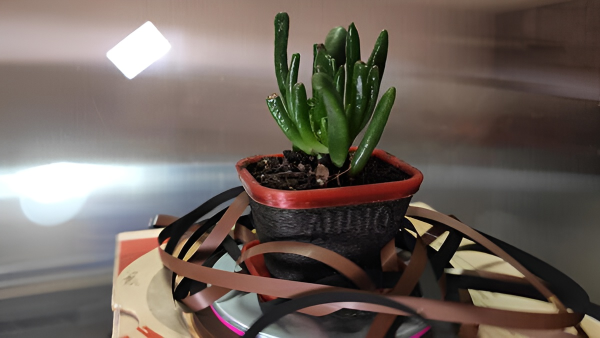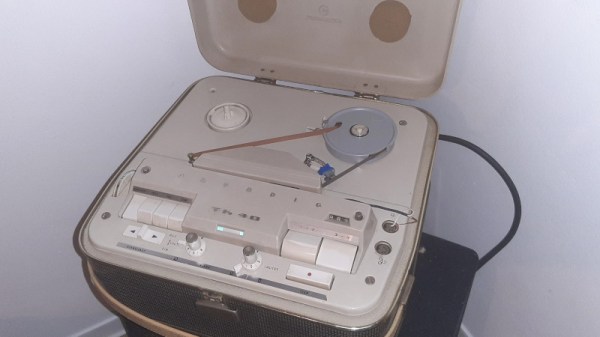“Emergency Law Enforcement Officer Hologram program activated. Please state the nature of your criminal or civil emergency.” Taking a cue from Star Trek: Voyager, the Seoul Metropolitan Police Agency is testing a holographic police officer, with surprisingly — dare we say, suspiciously? — positive results. The virtual officer makes an appearance every two minutes in the evening hours in a public park, presumably one with a history of criminal activity. The projection is accompanied by a stern warning that the area is being monitored with cameras, and that should anything untoward transpire, meat-based officers, presumably wearing something other than the dapper but impractical full-dress uniform the hologram sports, will be dispatched to deal with the issue.
reel-to-reel6 Articles
Not Repairing An Old Tape Recorder
When you think of a tape recorder, you might think of a cassette tape. However, [Michael Simpson] has an old Star-Lite small reel-to-reel tape machine. It isn’t a repair so much as a rework to make it work better. These cheap machines were never the best, although a $19 tape player back then was a luxury.
Part of the problem is that the design of the tape player wasn’t all that good to begin with. The motor runs off two C cells in parallel. When these were new in the 1960s, that would have meant conventional carbon-zinc batteries, so the voltage would have varied wildly. That didn’t matter, though, because the drive was directly to the tape reel, so the speed also varied based on how much tape was left on the reel.
The amplifier has four transistors. [Michael] decided to replace the capacitors on the unit. He noticed, too, that the volume control is in line with the microphone when recording, so even though the recording was supposedly in need of repair, it turned out to be simply a case of the volume control being turned down. Pretty impressive for a six-decade-old piece of consumer electronics.
The capacitor change-out was simple enough. Some cleaning and lubing was also in order. Did it help? You’ll have to listen and decide for yourself.
So, no real repair was in the works, but it is an interesting look back at an iconic piece of consumer tech. Tape recorders like this were an early form of social media. No kidding. If you’d rather not buy a tape recorder, you could roll your own.
3D Printer Filament From Reel-to-Reel Audio Tapes
At heart, 3D printers are just machines that can melt plastic “wire” into interesting shapes. It’s well-known and oft-lamented that plastic of various sorts has been used to make all manner of household objects that might eventually end up in landfill or otherwise littering the environment. With these facts in mind and a surplus of tape, [brtv-z] decided to see if he could recycle some old reel-to-reel audio tapes into working filament for a 3D printer.

This isn’t the first time he has tried to print with unusual second-hand polymers, back in 2020 he pulled of a similar trick using VHS tape. Through experimentation, it was soon determined that seven strands of quarter-inch tape could be twisted together and fused to form a very tough-looking filament approximately 1.7 mm in diameter, which could then be fed into the unsuspecting printer.
The resulting prints are certainly different in a number of respects from using virgin filament. The material is porous, brittle and (unsurprisingly) rather rusty-looking, but it does have some interesting properties. It retains its magnetism and it catches the light in an unusual way. The video is after the break (in Russian, but YouTube does a reasonable job of generating English captions).
Don’t have any tape handy? No worries, we’ve also covered machines that can recycle plastic waste into filament before. In fact, two of them even won the 2022 Hackaday Prize. What else could you melt down that might otherwise be thrown away?
Continue reading “3D Printer Filament From Reel-to-Reel Audio Tapes”
Making A Tape Echo The Traditional Way
[Juan Nicola] has taken inspiration from the musician hackers of old and re-purposed a reel-to-reel tape recorder into a tape-echo for his guitar with a built-in valve amplifier (video in Spanish).
The principle is to record the sound of the guitar onto a piece of moving magnetic tape, then to read it back again a short time later. This signal is mixed with the live input and re-recorded back onto the tape further back. The effect is heard as an echo, and this approach was very popular before digital effects became readily available.
[Juan] installed a new read-head onto his Grundig TK40 and managed to find a suitable mechanical arrangement to keep it all in place. He has since updated the project by moving to a tape loop, allowing an infinite play-time by re-using the same piece of tape over and over.
Turning tape machines into echo effects is not a new idea, and we’ve shown a few of them over the years, but every one is slightly different!
Both versions are shown after the break. YouTube closed-caption auto-translate might come in handy here for non-Spanish speakers.
Hackaday Links: April 14, 2019
Look at this prototype Apple smartphone from 1993! For a long time, Apple has been in the phone game, with many failed attempts to combine a laptop screen with a phone. The most noteworthy attempt would be the Snow White phone designed around 1982, but this didn’t go to market. Apple tried again in 1993 with the Walt phone, and now we have someone willing to tear open a prototype. The guts are apparently a contemporary PowerBook (something along the lines of a PowerBook 140 or 170), which means you’re probably looking at a 68030 processor and between 2 and 8 Megabytes of RAM. The rest of the hardware looks fairly standard; SCSI drive and a fax/modem adapter. The software, though, is Hypercard. Here’s the video of the thing booting, and it’s an interesting look at the ‘computer appliance’ trend from the late 90s; once again, Apple was ahead of the curve.
Disregarding any of the implications of geopolitics of the time (as we do with these sorts of things), the Horten Ho 299 was a jet-powered flying wing that first flew in 1944. It’s in the Smithsonian now (and on display, at Dulles) and is a weird, strange, but incredibly interesting footnote in aviation history (because of the implications of geopolitics at the time, but again, we’re not going to get into that). Now the Horten flies again. A company unrelated to Herr Horten has recreated the one-man flying wing. It’s a real experimental aircraft now. Sure, it’s a piston-powered airplane, but if you want to fly something that looks even cooler than something Burt Rutan grew out of fiberglass, this is what you want.
For the past few months, Hackster has been running a BadgeLove contest, now the entries are closed and the winners are here. The Badge Of All Badges is a contactless/NFC badge, the blinkiest has some awesome documentation, and the best art is directly from Pokemon Yellow.
Vinyl has made a comeback, and so far we’ve been accepting of that. The album art is better when it’s bigger, and a record is more of an experience than popping in a CD or streaming some music. There’s a reason your favorite Beatles song is the B-side of Abbey Road. What’s the next frontier of high-end audio? Reel to reel, and Thorens is making a new tape machine. First off: it costs thirteen thousand dollars. It’s a quarter inch tape, and yeah, you can totally find a machine that will play quarter inch tapes for far less money.
Due to my vocation, I am awash in press releases every day. This doesn’t give me access to technology trends, far from it. It gives me access to marketing trends. Want to know about the fog, or ‘the cloud at ground level’? The first time anyone with two brain cells saw that phrase was in an unsolicited email, and it’s in my inbox. The latest trend — and I assure you this didn’t happen last year — is advertising explicit targeted towards April 20th. 4/20 is now mainstream, because marketing decided you can sell stuff to stoners. I’m looking at an email right now that starts with, “Hi Brian, With 4/20 fast approaching I thought you’d be interested….” There’s another one for vapes. This year, 4/20 has become a consumer holiday, so this year be on the lookout for the new, innovative ways you’re being sold stuff.
Recording Off A Reel-to-reel With A Credit Card Reader

If you’ve got a few reel-to-reel recordings of 1940s radio, how do you transfer those to a digital medium? [Evan Long] and his dad used a credit card reader built for the iPhone to transfer a vintage [Art Kassel] recording from magnetic tape to the digital domain of .MP3s.
A few months ago, we saw what goes into these Square credit card readers. They’re just a magnetic tape head with a resistor an 1/8″ jack that plugs directly into the headphone jack of any iDevice. Because there’s no hardware limitation of what the Square credit card reader can do, [The Long boys] decided to back up some old reel-to-reel tapes with an iPod Touch.
[Evan] and his father needed to perform a few modifications to the credit card reader; the tape head pressed against the plastic case too tightly to allow feeding 70-year-old tape through the device. After bending a bit of metal the credit card reader was ready to record the dulcet tones of the Big Band era.
It’s a neat build, and anything that reuses proprietary hardware (however limited) is alright in our book. Nice job, guys.














